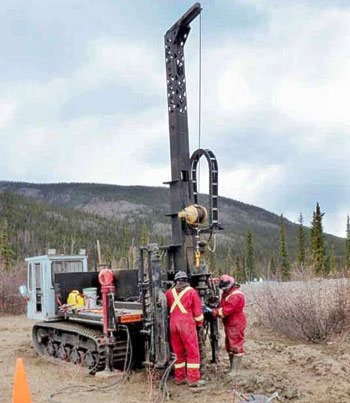If Victoria Gold Corp. has its way, an open-pit gold mine will open near Mayo by 2013.
Last month the Toronto-based company submitted a proposal to the Yukon Environmental and Socio-economic Assessment Board to mine its Eagle Gold deposit. It’s part of Victoria Gold’s Dublin Gulch property, found 85 kilometres northeast of Mayo.
Eagle Gold deposit has an indicated resource of 2.7 million ounces of gold. The company reckons it’s sitting on enough paydirt to operate a mine for at least eight years.
And, as the company continues to make new finds with its drillwork at the site, “we think it’ll be there a lot longer,” said Chad Williams, Victoria Gold’s president and CEO.
If a mine materializes, it could employ up to 400 people. But that’s still far from a certainty, as the proposal must still wend its way through the territory’s regulatory system. Williams aims to see the project clear all hurdles over the next 18 months.
Victoria Gold plans to extract the gold by dousing giant piles of ore with cyanide. The method, called a heap leach, was used by the former Brewery Creek mine near Dawson City.
Much excitement has been generated over the past two years about new gold discoveries at the White Gold district near Dawson City and the Rau property near Keno City. But these finds, however promising, have several years of drillwork ahead of them before their gold resources are firmly sized-up.
Dublin Gulch, by comparison, is at a more advanced stage of exploration. The Eagle Gold deposit was first found about 25 years ago.
The slump in gold prices during the late 1990s put this work on hold under Victoria Gold’s predecessor. Skyrocketing gold prices have given the project new urgency.
An economic report prepared by Victoria Gold in the spring of 2010 foresaw production costs of $503 per ounce. As long as gold prices stay aloft – this week, the metal’s price floated at $1,380 per ounce – the company ought to enjoy fat profit margins.
If the project proceeds, “it’ll be the largest gold mine in the history of the Yukon,” said Williams. “There are no other gold deposits in the Yukon that come close to our size.”
For now, Victoria Gold is upgrading its camp, replacing tents with trailers and expanding the number of bunks to hold up to 100 people. This bigger, more permanent camp ought to help the company extend the length of its exploration programs, said Williams.
“Hopefully we can drill virtually year round. As you know, January and February aren’t the friendliest, weather-wise, up there. So it’ll be the best as humanly possible.”
Victoria Gold spent $5 million on exploration in 2010. This year’s exploration program will be “at least that,” said Williams, “perhaps substantially more.”
The proposed mine would cost $250 million. Part of that money would be raised through revenues from another mine owned by the company in Nevada.
Victoria Gold’s largest shareholder also has deep pockets. It’s Kinross, one of Canada’s biggest gold producers.
Other than permitting, the other big challenge the company faces is obtaining a “social licence,” as Williams calls it, from the Na-Cho Nyak Dun.
About one year ago, the company struck a memorandum of understanding with the First Nation. And last autumn, the company flew aboriginal elders to Kinross’ Fort Knox open-pit gold mine, located near Fairbanks, to show them what a modern-day gold mine looks like.
The two parties are now seeking to reach an impact-benefit agreement, which typically guarantees the First Nation a share of the jobs and profits.
Contact John Thompson at johnt@yukon-news.com.
